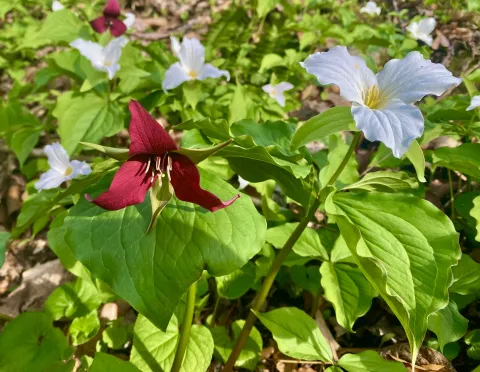Trillium Trivia

Trilliums are one of the earliest flowers to bloom in the Spring, and are beautiful to behold.
By Steve Roark
Volunteer, Cumberland Gap National Historical Park
One of the most beautiful wildflowers to see in the Spring are trilliums, which are members of the Lily family. They are easy to find this time of year in rich, moist woods along rivers, streams, and in deep hollows. There are several species growing in our area, and all are easy to identify. The average trillium is 12 to 18 inches tall with a stout, erect stem. At the top is a whorl of 3 broad leaves and a single flower with 3 petals. Most trilliums have a flower supported by a stem just above the leaves (botanists call this pedicellate). But sessile trillium, also known as toadshade, (Trillium sessile) has no flower stem and the 3 petals appear to come directly out of the leaves. The sessile trilliums I have found locally have yellow petals, but some are dark red. The leaves of sessile trilliums have whitish splotches.
Here is a description of some other local trilliums: White trillium (Trillium grandifolia) has large white petals that gradually turn pinkish as they age. Red trillium (Trillium erectum) is also called wakerobin and has blood red flowers. Probably the prettiest trillium in the forest is painted trillium (Trillium undulatum), which has small white flowers with a blaze of red in the center. I’ve only found it in big mountain country.
Historically, trillium has served as both a food and medicinal. The root is a bulb and has been used to treat convulsions, induce menstrual flow, induce vomiting, and as an expectorant. Indians also cooked pieces of root with other food as an aphrodisiac. The leaves of trillium have been used as a salad or cooked green if picked before they fully unfold. Most would prefer that trillium be left alone to provide a nice splash of color to a spring woodland walk.
Some other interesting trillium trivia includes their surprising longevity for a small herbaceous plant, on average 25 years. Trillium seeds have an oily sack (an elaiosome in botany speak) attached to them that is protein rich and very attractive to ants, who carry the sack to their nest to consume, and then discard the seed, thus helping spread them around to other places.
Trilliums are in a group of plants known as spring ephemerals. These plants have a very short period of active growth, emerging from the ground, blooming and producing seeds while the forest trees above them are still leafless, which allows sunlight to reach the ground and power the whole growth cycle via photosynthesis. Pay attention to what greens up first in a forest, for it will most likely be these small herbaceous plants popping out of the leaf litter.
- Log in to post comments